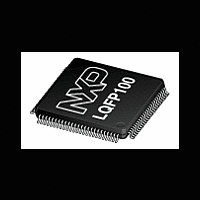LPC2361_62 NXP Semiconductors, LPC2361_62 Datasheet - Page 16

LPC2361_62
Manufacturer Part Number
LPC2361_62
Description
The LPC2361/2362 microcontrollers are based on a 16-bit/32-bit ARM7TDMI-S CPU with real-time emulation that combines the microcontroller with up to 128 kB of embedded high-speed flash memory
Manufacturer
NXP Semiconductors
Datasheet
1.LPC2361_62.pdf
(64 pages)
NXP Semiconductors
LPC2361_62
Product data sheet
7.5.1 Interrupt sources
7.5 Interrupt controller
7.6 Pin connect block
7.7 General purpose DMA controller
The ARM processor core has two interrupt inputs called Interrupt Request (IRQ) and Fast
Interrupt Request (FIQ). The VIC takes 32 interrupt request inputs which can be
programmed as FIQ or vectored IRQ types. The programmable assignment scheme
means that priorities of interrupts from the various peripherals can be dynamically
assigned and adjusted.
FIQs have the highest priority. If more than one request is assigned to FIQ, the VIC ORs
the requests to produce the FIQ signal to the ARM processor. The fastest possible FIQ
latency is achieved when only one request is classified as FIQ, because then the FIQ
service routine can simply start dealing with that device. But if more than one request is
assigned to the FIQ class, the FIQ service routine can read a word from the VIC that
identifies which FIQ source(s) is (are) requesting an interrupt.
Vectored IRQs, which include all interrupt requests that are not classified as FIQs, have a
programmable interrupt priority. When more than one interrupt is assigned the same
priority and occur simultaneously, the one connected to the lowest numbered VIC channel
will be serviced first.
The VIC ORs the requests from all of the vectored IRQs to produce the IRQ signal to the
ARM processor. The IRQ service routine can start by reading a register from the VIC and
jumping to the address supplied by that register.
Each peripheral device has one interrupt line connected to the VIC but may have several
interrupt flags. Individual interrupt flags may also represent more than one interrupt
source.
Any pin on PORT0 and PORT2 (total of 42 pins) regardless of the selected function, can
be programmed to generate an interrupt on a rising edge, a falling edge, or both. Such
interrupt request coming from PORT0 and/or PORT2 will be combined with the EINT3
interrupt requests.
The pin connect block allows selected pins of the microcontroller to have more than one
function. Configuration registers control the multiplexers to allow connection between the
pin and the on-chip peripherals.
Peripherals should be connected to the appropriate pins prior to being activated and prior
to any related interrupt(s) being enabled. Activity of any enabled peripheral function that is
not mapped to a related pin should be considered undefined.
The GPDMA is an AMBA AHB compliant peripheral allowing selected LPC2361/2362
peripherals to have DMA support.
The GPDMA enables peripheral-to-memory, memory-to-peripheral,
peripheral-to-peripheral, and memory-to-memory transactions. Each DMA stream
provides unidirectional serial DMA transfers for a single source and destination. For
All information provided in this document is subject to legal disclaimers.
Rev. 5 — 25 October 2011
Single-chip 16-bit/32-bit MCU
LPC2361/62
© NXP B.V. 2011. All rights reserved.
16 of 64














